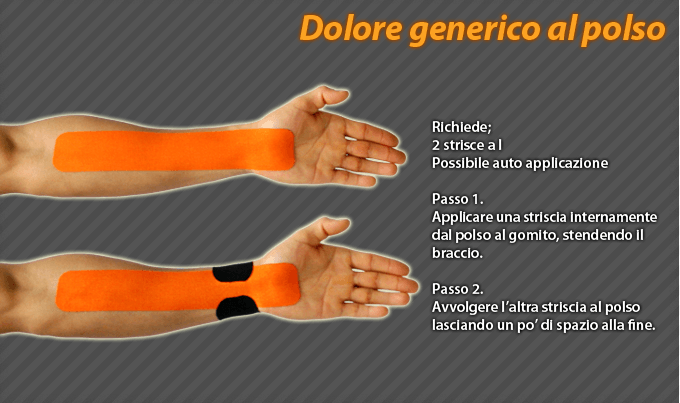GENERAL APPLICATION GUIDES
Neuromuscular physiotapes - reduce: inflammation, pain, cramps, scars, muscle fatigue, excessive contractions, onset of muscle injuries. - improve: muscle contraction, joint alignment, blood circulation, circulation of lymphatic fluids.
Basic Precautions
1. Clean your skin before applying the tape.
2. Two ways of paper film removal.
1) Place the tip of your thumb on the top edge of the tape, and then simply place your thumb back along and towards your body.
2) Since the tension of the ribbon is different from that of the paper backing, it comes off as a result of the twisting of the ribbon itself.
3. To apply the tape to the painful surface, the skin and muscles of the affected area must be fully stretched before applying the tape.
Do not stretch the tape itself, and then leave it for 3~5 days.
4. When the length of the tape is measured, cut the tape next
have stretched the muscle to which you are about to apply the tape.
5. After bandaging, there should be some wrinkles when the body returns
in the normal position.
6. If the tape is wet after bathing or showering, dry the tape using
a fan.
7. When removing the Ares Kinesiology Tape, pull the tape slowly in the direction of the hair. Pay special attention to children and the elderly at the end
to avoid damaging the skin.
8. Attach the tape to the skin, and be careful not to overlap it.
9. If you experience itching or discomfort after applying the tape, remove the tape immediately.
KINESIO TAPING APPLICATIONS
The Kinesio Taping method does not include applications that are difficult to implement, however it is difficult to identify the correct application for each individual patient.
For this reason, Kinesio always recommends consulting a CKTP (Certified Kinesio Taping Practitioner) for evaluation and treatment.
In this section you will find some of our suggested applications for different conditions.
These applications can be found in our Kinesio Taping manuals along with numerous other applications and conditions and are taught to professionals during learning courses.
Knee
Neuromuscular Taping is a method used in numerous pathologies related to the ligaments and knee joint.
It is applied to prevent and treat injuries, femoropatellar or femorotibial chondritis and knee tendonitis. Taping is highly appreciated by athletes who often find themselves having to limit their passions due to joint limitations caused by meniscus defects.
The bio-mechanical function of kinesiology tapes reduces joint strain as it decreases ligament stress during physical activity and aligns the sliding axis of the patella between the femoral condyles.
The instructions for the kinesiological application of the tapes on the knee follow.
Elbow
Neuromuscular Taping is a method used in numerous elbow-related pathologies, both post-traumatic and inflammation-related such as epicondylitis, epitrochleitis and pain from insertional ligaments.
It is indicated as an aid during rehabilitation therapies and for muscle or joint discomfort and pain.
Elbow taping is recommended in the case of tendon inflammation: a very common pathology among athletes (it is no coincidence that it is commonly called "tennis or golfer's elbow") and subjects who usually stress or keep tendons under stress (internal or external). ) of the elbow.
The instructions for the kinesiological application of the tapes on the elbow follow.
Carpal Tunnel
Forearm
Wrist
Thousand
Calf, ankle and foot.
Neuromuscular Taping is a method used in numerous calf-related pathologies
and ankle, and is applied both in case of injuries (to prevent them or in the rehabilitation phase), and in case of inflammation, pain and discomfort
Kinesiology Tapes are indicated for the most common ankle pathologies: capsuloligamentous distortion (sprains and distracting traumas), instability, muscular stress syndromes of the lower limbs.
Calf taping is recommended in case of muscle tears, inflammation, contractures or strains.
Ankle taping is used in cases of joint instability, ligamentitis of the Achilles tendon, and following joint trauma (it is recommended for example for the rehabilitation phase following a sprain)
Foot
Leg muscles
Back
Neuromuscular Taping is a method used in numerous back-related pathologies.
It is applied with the aim of preventing low back pain caused by stressful daily attitudes of the spine and load-bearing efforts.
Back taping is recommended in the case of muscle contractures, musculoskeletal pain, general back pain and witch stroke.
Kinesiology Tapes are particularly suitable for subjects subjected to stress of the lumbosacral hinge, postural defects, prevention of excessive loads from the gym or from work.
The instructions for the kinesiological application of the tapes on the back follow.
Abdomen
Breastplate
Shoulder
Neuromuscular Taping has multiple therapeutic indications in shoulder arthralgia. It is applied in the most frequent pathologies: bursitis under acromialis, alterations of the supraspinatus tendon, in the rehabilitation phase in the after-effects of shoulder dislocation and in periarthritis cases.
Shoulder taping facilitates bio-mechanical function by reducing joint strain and limiting movement.
The instructions for the kinesiological application of the tapes on the shoulder follow.
Biceps-Triceps
Neck-Cervical area

















































































